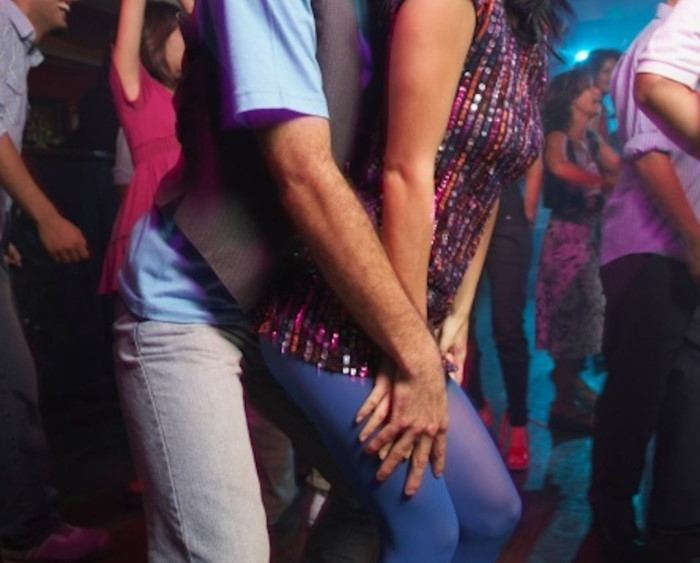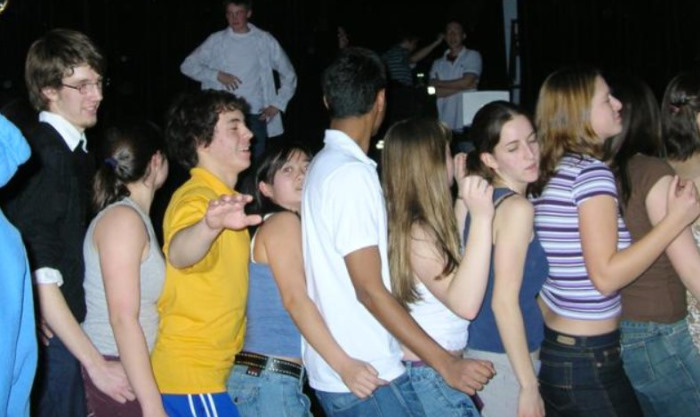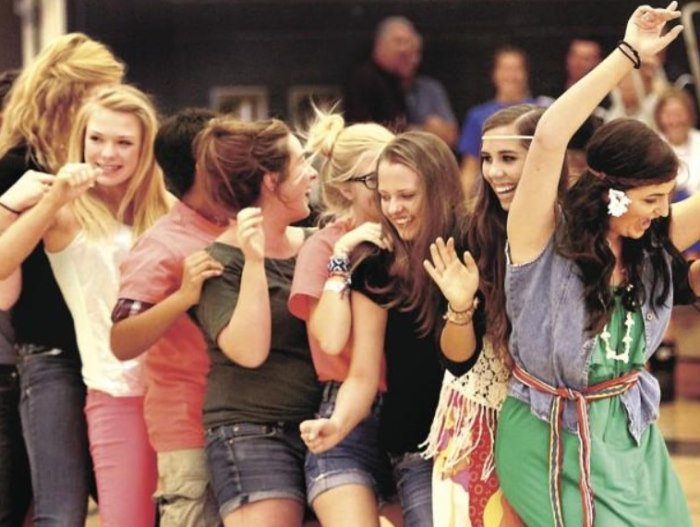Sexually suggestive and incredibly bold, the grinding dance is super popular among college students and young folks. Just go to any frat party and you’re almost guaranteed to see a pair doing this dance.
It’s a pretty straightforward dance, all things considered. Some people don’t even think it’s a dance at all because of its simplicity.
However, in our opinion, the grinding dance – albeit simple – is a totally valid form of dance and worth looking into. In this guide, we define grinding, explore its roots, discuss why it’s both celebrated and banned, and clarify how it’s distinct from twerking and other moves.
Table of Contents
What Is Grinding Dance?
The grinding dance definition is a type of partner dance wherein the two partners will rub their bodies against one another (grinding). Usually, the partners are of the opposite sex.
The female dancer will rub her buttocks against her partner’s crotch. Meanwhile, the male partner will have his hands on either her waist, hips or buttocks (depending on the level of closeness).
Because of the provocative nature of this pose, this type of dance has been a controversial dance form for a long time, especially among parents.
Another word for the grinding dance is “freak dancing”.

Grinding Dance Origin
Grinding has a fairly long and rich history. It is a mixture of many types of dances. For example, one of the dances that made up the modern grinding dance can be traced back to the Caribbean.
Back in the day, there was a type of dance where the dancers would thrust and gyrate their hips to the music, called “whining” or “djuking”.
This dance migrated from the Caribbean to the United States during the 70s, where it was adopted by the nascent hip-hop movement at the time.
Another dance that is said to be a predecessor of grinding is “The Bump.”
Similar to the grinding dance that we all know (and some love) today, it’s a fairly sexually provocative dance.
It popped up and became popular in the late 70s.In it, the dancer would “bump” other people using their hips or their buttocks.
Unlike the modern grinding dance, “The Bump” didn’t involve full-on contact, and the touch was temporary.
Grinding vs. Juking Dance
Many people confuse grinding and juking. It’s understandable, considering how both are very similar to one another.
Similarities
Both types of dances are performed by two people. Usually, it’s between a man and a woman.
However, a man-to-man or woman-to-woman coupling isn’t uncommon. The pair of dancers can be friends or lovers.
You can partner up with perfect strangers, too, so long that you have their consent.
Differences
There are two popular forms of grinding dance. The first one involves one partner (usually the male) rubbing his pelvis against the bottom of the partner.
In the second form, both participants face one another and grind their pelvic areas together to the rhythm of the music.
Juking, on the other hand, involves one partner (usually female) actively rubbing their buttocks against their partner (usually male).
The latter will typically put their hands on their partner’s hips, waist, or – if allowed – buttocks.
Juking is different from grinding because the active partner (female) controls the rhythm and movement. The other person just follows along.
In the grind dance, both dancers usually have equal control over each other’s movements.
Grinding can also be done by many people at the same time. A long line of people can form a line, then rub their pelvis and buttocks against the person in front or behind them.
The whole line will move to the beat of the music and mirror each other’s movements. This “grinding chain” is quite popular at large parties or clubs.

Grinding vs Twerking vs Perreo
- Grinding: close partner dance with bodies pressed together
- Twerking: solo, focused on lower-back and thigh isolations, not body-to-body contact
- Perreo: reggaeton partner style emphasizing hips, with woman often in control
How to Grind?
Knowing what grinding involves is just one thing, actually doing it is yet another.
Though it may look wild and spontaneous, this dirty dance has a fair bit of technique to make it look good (and possibly even feel good).
However, we must warn you that it’s crucial to ask for consent before you try to grind someone else.
This type of dance is sexually charged and intimate enough that you can get into a lot of trouble if your partner isn’t on the same page as you.
It doesn’t matter if the person you’re trying to dance with is a stranger, acquaintance, friend, or even lover; it’s always best to ask for permission.
- Start on the dance floor. If you’re going with friends, dance a few tracks with them first to loosen up your muscles and “charge up” your confidence.
- After you have felt more at home on the dance floor, start looking for a partner. Look around and find someone that suits your eyes, then look at them from afar.
- Move up to them naturally by gradually shifting closer to them during the song.
- Maintain eye contact to signal your interest. At this point, you should gauge their reactions carefully, too. If they meet your eyes and seem interested, keep coming closer.
- Once you’re close enough, you can lightly brush against them (maintain eye contact and a smile). If they match your movement or reciprocate your signals, you can make bolder, more forward moves.
The next step will depend on what role you wish to play in the dance.
As we mentioned earlier, the person at the front and actively grinding is usually female, while the person at the back is male.
But remember that it’s not rare for males to dance with one another or females. So, we’ll try to keep this as neutral as possible.
- If you want to be at the front, turn around and face away from your partner.
- Then, move your buttocks and hips in a circular motion. At this point, if your partner understands the assignment, they will match your movement with their hips, too.
Alternatively, if you want to be the person to the back, you can move behind your partner.
If you both are strangers, it’s better to sway your hips a foot of distance behind the other person. Unless you know they’re interested in dancing with you, it’s best to keep your hands off them at this stage.
As you gyrate your hips, maintain communication with eye contact, a friendly smile, and an open expression.
Should they know what they’re doing, they should move their hips to your rhythm, too.
Some tips
If you’re feeling bold and have their consent, or you already intimately know the person you’re dancing with, you can move closer to them during the dance.
If you’re the partner at the back, you can place your hands on their hips, waist, or buttocks. And if you’re dancing at the front, you can touch your swaying buttocks to their pelvis area.
Your hip movement and the friction between your bodies are key to a fun and exciting grind. Pay close attention to these factors as well as your partner’s reactions.
But no matter what you do and how much fun you have, keep two principles in mind.
Firstly, you’re under no obligation whatsoever. If you suddenly feel uncomfortable (which can happen as this is a very intimate dance), move away and don’t force yourself. It’s okay to have boundaries.
Secondly, and we can’t stress this enough, always ensure that you get explicit consent from your partner. If they seem uncomfortable (especially strangers), take it in good strides and move away.
Grinding Once Got Banned in High School
After it was adopted and subsequently popularized by the hip-hop movement, the grinding dance was soon found at parties and proms across the United States, much to the alarm and chagrin of parents and teachers.
School administrators back in the days even went as far as trying to outright ban grinding dance at high schools due to its explicit nature.
But of course, the ban didn’t affect its popularity by much. Kids still did it (and they’re still doing it today).
We weren’t surprised by this development; it wasn’t just because teenagers are naturally rebellious.
While it certainly looks explicit, the grinding dance is used as a way for young people to discover their own sexuality. It allows them to be publicly intimate.
More importantly, as the mindset around sex and intimacy becomes more and more liberalized among young people, the grinding dance serves as a medium through which they can express themselves.
So, while people look at it as a sort of “bad” and “rebellious” dance form, underneath the surface it is merely a form of expression and a way to have fun.
Clothes for Grinding Dance
Grinding dance is usually done in informal settings like house parties, dance clubs, or bars. So, there’s no “uniform,” per se.
However, some clubs and parties have dress codes, so pay attention to those.
Grinding Dance Songs
- Stand Up – Ludacris [feat. Shawnna]
- Ludacris Hot In Herre: Nelly
- Don’t Cha: The Pussycat Dolls
- What’s Your Fantasy [feat. Shawnna]
1. Is grinding dance appropriate anywhere?
Grinding can be appropriate in social settings like clubs or 18+ parties where attendees are comfortable with close contact rap and R&B. It’s less suited to formal spaces (e.g., weddings with older guests or school gatherings) unless culturally normal there.
2. How can teens handle grinding at prom safely?
Prom attendees should prioritize consent and respect. Open communication (e.g., “Is this okay?”), maintaining awareness of chaperones, and moderating proximity ensure dancing remains fun and drama-free.
3. Is grinding considered exploitative or empowering?
Perceptions vary – some see it as objectifying, while others view it as empowered expression of sexuality and identity. Cultural background, personal boundaries, and relationship power dynamics all shape its meaning for individuals.
Final Words
The grinding dance is a wild, liberating dance form. Albeit simple, it is a great way to make your experience at a dance party more exciting.
And maybe (only maybe), you will end up meeting someone you can get to know far more intimately.
Remember, this dance is known for its sexual nature. So it’s not exactly uncommon for strangers who paired up on the dance floor to leave the club together, also.
